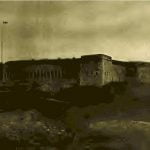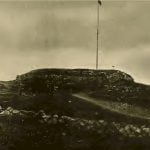
The sunny waters of the Thames at New London, Connecticut, present a smiling aspect, and from the high flagstaff of trig little Fort Trumbull the stars and stripes float gaily. Across the river on the hill above the little town of Groton is the State reservation containing the remains of Fort Griswold, with rough zigzag paths approaching the summit of the hill. Adjacent to Fort Griswold is the stone monument which commemorates the Fort Griswold massacre. Many sunny years will not wipe out the memory of the bloody deeds of that violent hour.
Fort Trumbull is situated one mile from the mouth of the Thames River and one mile and a half below the little city of New London, with whose history it is associated. A modest work of substantial construction, it covers only thirteen acres and is so restricted for living space that it cannot accommodate a full garrison within its walls. Fort Griswold is a work of far more ancient and rougher construction. It is not garrisoned today and has not been garrisoned for many years, though in the fighting days of the two forts it was the more important of the two places.
The little village of New London is a favored watering place for many in summer and its safe and accessible harbor has made it desirable as a haven for the storage of summer light craft during the winter months. These same considerations hold true of Groton on the other side of the river. Thousands of visitors every summer go over the historic defenses of Fort Griswold or gaze upon the equally historic site of Fort Trumbull.

The erection of two forts was begun in 1775 by the citizens of New London and Groton, one on the west side of the Thames which was designated in the correspondence of the time as a “blockhouse with embrasures,” and the other, a more pretentious work, on the east side of the river and designated at once “Fort Trumbull.” In 1776 Washington directed General Knox to examine the harbor of New London. This gentleman carried out his commission in workmanlike fashion and reported that the harbor was a safe and well protected retreat for vessels in any wind that blew. The harbor is three miles long and seldom encumbered with ice.
In that same year Captain Shapley was ordered to take command of Fort Trumbull, and Colonel William Ledyard of Fort Griswold on Groton Hill. Later, Ledyard was placed in command of the two positions. In 1777 he revised, strengthened and enlarged Fort Trumbull, and in 1778 performed this same work upon Fort Griswold. Under his direction, in 1779, strong works were thrown up on Town Hill, New London. Finally, in 1780, the assembly of New London ordered his accounts paid.
The successful operations of the Continental forces in Virginia in 1781 caused Sir Henry Clinton to cast about for some means of distracting his opponents and of recalling Washington from the South, preferably by some deed of enterprise in the North. He fixed on New London as the scene of operations, as he had heard that there were many stores in the little town, and as the leader of the expedition he picked out Benedict Arnold, the traitor, who had just returned from scenes of pillage on the James River, Virginia. The choice of Arnold may have appealed to some saturnine sense of humor in Clinton, as Connecticut, it may be remembered, was Arnold’s native State and New London not far from the scenes of his boyhood.
The little works at New London and Groton, despite the conscientious efforts of Colonel Ledyard, were not positions of much consequence. Fort Trumbull, we are told, was merely a strong breastwork of three sides, and open in the rear, mounting eighteen 12pound guns and three 6pound guns. Its garrison numbered twenty-three men. Fort Griswold was somewhat more formidable, being “an oblong square with bastions at opposite angles, its longest side fronting the river in a northwest and southeast direction, its walls of stone 10 or 12 feet high on the lower side and surrounded by a ditch; in the wall pickets projected over for 12 feet; above, a parapet with embrasures and within a platform for cannon, with a step to mount to shoot over the parapet with small arms.”
In addition to these, the main defenses there was the little work on the summit of Town Hill, New London, which mounted six small bore guns and which had become known by the airy title of “Fort Nonsense.”
It being manifestly impossible to hold Fort Trumbull with a force of twenty-three men, the Americans, on the approach of Arnold and the British, took all of their forces and placed them in Fort Griswold. At its best the garrison of this point was not as numerous as the attacking body and it was made up of untrained militia gathered at the moment’s call.
The result of the battle, when battle was finally given, was a foregone conclusion. The British soldiery landed September 6, 1781, and advanced in force. The plucky American garrison tried desperately to hold back the onslaught, fighting most of the men in sight of their own homes, but without effect. After a sharp engagement the fort was taken and the conclusion of the combat was a signal to Arnold’s forces for an indiscriminate slaughter of the Americans, many of whom had thrown down their arms. Of the 160 men making up the garrison all but 40 were killed or wounded, and the vast majority of them after resistance had ceased. The wounded, contemporary testimony asserts, were placed in carts under Arnold’s direction and dumped over the edge of the hill here which is very steep.
The British then entered Groton and New London and set them on fire. Arnold finally led his forces back to New York.
To commemorate the gallant defense of Fort Griswold and the terrible scenes which it had witnessed, the State of Connecticut began the erection of a monument on Groton Heights in 1830 and carried the shaft to the height of 127 feet. At this height the monument rested until 1881, when it was carried eight feet higher. On the face of the shaft is a tablet, which bears the following inscription:
This monument was erected under the patronage of the State of Connecticut, a.d. 1830 and in the 55th year of the independence of the United States, in memory of the brave patriots who fell in the massacre at Fort Griswold on this spot on the 6th of September, a.d. 1781, when the British under the command of the traitor Benedict Arnold burnt the towns of New London and Groton and spread desolation and woe throughout this region.
Various spots in the little grounds of the fort have been marked with tablets. The grounds are carefully maintained and are open to visitors at all times.
Though no effort was ever made to rebuild Fort Griswold, a like fate did not befall Fort Trumbull. At the outbreak of the War of 1812 the embankments of Fort Trumbull were nothing but green mounds. A formal work was commenced, leaving the old blockhouse inside the new lines. During this war the fort was often threatened but never attacked.
An anecdote which shows the spirit of the locality is retailed by Lossing: 1
When the British squadron which drove Decatur into the harbor of New London in 1813 menaced the town with bombardment the military force that manned the forts were deficient in flannel for cannon cartridges. All that could be found in New London was sent to the forts and a Mr. Latham, a neighbor of Mrs. Anna Bailey’s, came to her at Groton seeking for more. She started out and collected all the petticoats of little children that she could find in town. “This is not half enough,” said Mr. Latham on her return. “You shall have mine too,” said Mrs. Bailey as she cut with her scissors the string that fastened it, and taking it off gave it to Latham. He was satisfied, and, hastening to Fort Trumbull, that patriotic contribution was soon made into cartridges. “It was a heavy new one but I did not care for that,” said the old lady while her eyes sparkled. “All I wanted was to see it go through the Englishmen’s insides.” Some of Decatur’s men declared that it was a shame to cut that petticoat into cartridge patterns; they would rather see it fluttering at the masthead of the United States or the Macedonia as an ensign under which to fight upon the broad ocean.
The present Fort Trumbull was begun in 1839 on the foundations of its two predecessors and finished at a cost of $250,000. Part of the old blockhouse of the first Fort Trumbull is still preserved in the confines of the present fort.
Citations:
- Lossing, vol. i, p. 617.[↩]
